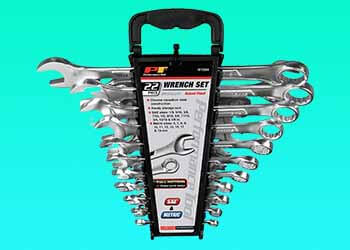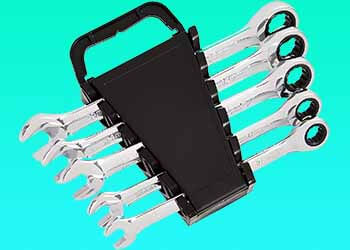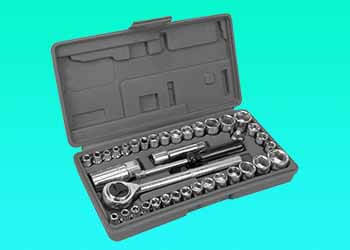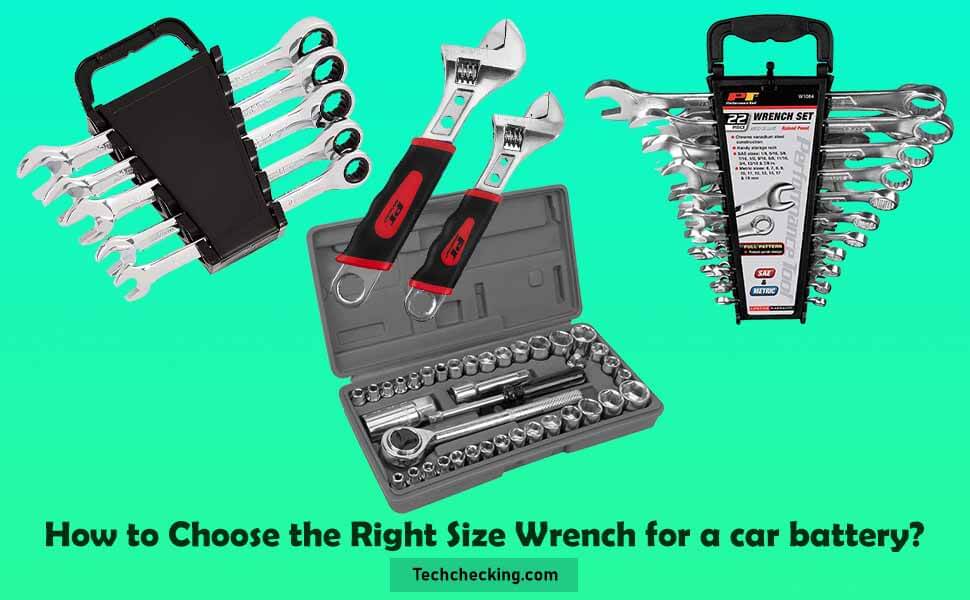When it comes to maintaining your car, choosing the right tools is essential for keeping it running smoothly. One of the most important tools you’ll need is a wrench, particularly when it comes to working on the car battery. However, using the wrong size wrench can cause damage to both the battery and the car. In this blog post, we’ll discuss how to choose the right size wrench for a car battery, so you can avoid these issues and keep your car in top condition. We’ll cover factors to consider, how to measure the battery terminals, the different types of wrenches to use, and common mistakes to avoid. Let’s get started!
How to Choose the Right Size Wrench for a car battery?

Choosing the right size wrench for your car battery is crucial to ensuring a secure and safe connection. Using the wrong size wrench can result in damaging the battery terminals or cables, which could lead to costly repairs down the line. To avoid this, you need to choose the right size wrench for the job.
The first step in choosing the right size wrench is to determine the size of your battery terminal. You can do this by measuring the terminal diameter or by checking the owner’s manual or manufacturer’s website for the size information. Once you have determined the size, you can choose a wrench that fits over the terminal snugly without slipping or wobbling.
It’s essential to choose a wrench that fits tightly over the battery terminal to prevent any damage to the terminal or cables. If the wrench is too small, it may slip off the terminal, and if it’s too large, it may damage the terminal or cables due to excess force. Choosing the right size wrench will make the job easier, faster, and more efficient, which is especially important when you’re working on a car battery in harsh weather conditions.
In addition to choosing the right size wrench, you may also want to consider the type of wrench that’s best for your needs. Open-end wrenches, box-end wrenches, adjustable wrenches, and combination wrenches are all suitable for working on car batteries, and each has its advantages and disadvantages.
In summary, choosing the right size wrench is essential when working on your car battery. Take the time to measure your battery terminal and select a wrench that fits snugly over the terminal without slipping or wobbling. Doing so will help prevent damage to the terminal or cables and make the job easier and more efficient.
Related: What Size Wrench for a Car Battery?
Why is Choosing the Right Size Wrench Important?
Choosing the right size wrench for your car battery is important for several reasons.
Firstly, using the wrong size wrench can cause significant damage to both the battery and the car. If the wrench is too small, it may not be able to apply enough torque to loosen or tighten the battery terminal bolts, potentially leading to stripped threads or rounded edges. On the other hand, if the wrench is too large, it may not fit snugly around the bolt, causing slippage and damage to the terminal or battery casing.
Secondly, choosing the right size wrench can ensure that you’re able to work on the battery more efficiently and safely. Using a wrench that fits snugly around the bolt reduces the risk of slipping or losing your grip, which can lead to injury or damage to the battery or car.
Lastly, using the right size wrench can save you time and money in the long run. By avoiding damage to the battery or car, you won’t have to spend money on repairs or replacements, and you can get the job done faster and with less hassle.
Overall, choosing the right size wrench is an important aspect of car battery maintenance, and can help ensure that your car stays in good condition for years to come.
Some Different Sizes Wrenches from Amazon –
Factors to Consider When Choosing a Wrench Size

When choosing a wrench size for your car battery, there are several factors to consider. Here are some of the most important ones:
- Battery Terminal Size: The size and shape of the battery terminals will determine the size of the wrench needed. Measure the diameter of the bolt head to determine the right size wrench.
- Clearance: Check the amount of space available to access the battery terminals. If the space is tight, you may need a wrench with a shorter handle or a ratchet wrench that allows you to work in tight spaces.
- Torque Required: The amount of torque required to loosen or tighten the battery terminal bolts will also determine the size of the wrench. Make sure to use a wrench that is capable of applying enough torque without over-tightening.
- Type of Wrench: There are different types of wrenches available, including adjustable wrenches, socket wrenches, and box-end wrenches. Consider which type of wrench is best suited for the job and choose the appropriate size.
- Material: The material of the wrench can also affect its effectiveness. Look for a wrench made of durable materials that can withstand heavy use and provide a secure grip.
By considering these factors, you can choose the right size wrench for your car battery and ensure that you’re able to work on it safely and effectively.
Measuring the Battery Terminals
Measuring the battery terminals is an important step in choosing the right size wrench for your car battery. Here’s how you can do it:
- Determine the type of battery: Different types of batteries have different terminal sizes and shapes. The most common types are top-post and side-post batteries.
- Clean the battery terminals: Before measuring the terminals, make sure they are clean and free from any corrosion or dirt. Use a wire brush or battery cleaner to remove any debris.
- Measure the diameter of the bolt head: Use a caliper or a tape measure to measure the diameter of the bolt head on the terminal. Make sure to measure the widest part of the bolt head.
- Compare the measurement to a wrench size chart: Look up the measurement on a wrench size chart to determine the appropriate size wrench for the terminal.
- Consider the shape of the terminal: Some battery terminals have unique shapes that may require a specialized tool or an adjustable wrench.
It’s important to choose the correct size wrench to avoid damaging the terminal or the battery. Taking the time to accurately measure the terminal will help ensure that you choose the right size wrench for the job.
Determining the Correct Wrench Size
Once you have measured the battery terminals, you can determine the correct wrench size to use. Here are some steps to follow:
- Look up the terminal diameter on a wrench size chart: Use the measurement you obtained to find the corresponding wrench size on a chart. The chart will typically list the size of the bolt head and the corresponding wrench size in both standard (inches) and metric (millimeters) units.
- Check the fit of the wrench: Try the wrench on the terminal to ensure it fits snugly around the bolt head. The wrench should not be loose or slip off the bolt head.
- Consider using an adjustable wrench: If you are unable to find a wrench that fits the terminal precisely, consider using an adjustable wrench. An adjustable wrench can be adjusted to fit a variety of bolt sizes, making it a versatile tool to have in your toolkit.
- Consider the torque required: Make sure to choose a wrench that is capable of applying the necessary torque to loosen or tighten the battery terminal bolts. Using a wrench that is too small or too large may not provide enough torque or may over-tighten the bolts, causing damage.
By following these steps, you can determine the correct wrench size to use for your car battery and ensure that you’re able to work on it safely and effectively.
Determining the Correct Wrench Size
Once you have measured the battery terminals, you can determine the correct wrench size to use. Here are some steps to follow:
- Look up the terminal diameter on a wrench size chart: Use the measurement you obtained to find the corresponding wrench size on a chart. The chart will typically list the size of the bolt head and the corresponding wrench size in both standard (inches) and metric (millimeters) units.
- Check the fit of the wrench: Try the wrench on the terminal to ensure it fits snugly around the bolt head. The wrench should not be loose or slip off the bolt head.
- Consider using an adjustable wrench: If you are unable to find a wrench that fits the terminal precisely, consider using an adjustable wrench. An adjustable wrench can be adjusted to fit a variety of bolt sizes, making it a versatile tool to have in your toolkit.
- Consider the torque required: Make sure to choose a wrench that is capable of applying the necessary torque to loosen or tighten the battery terminal bolts. Using a wrench that is too small or too large may not provide enough torque or may over-tighten the bolts, causing damage.
By following these steps, you can determine the correct wrench size to use for your car battery and ensure that you’re able to work on it safely and effectively.
Read More: What Size Allen Wrench to Tighten Moen Kitchen Faucet Handle?
Types of Wrenches to Use for Car Batteries

There are a few types of wrenches that are commonly used for working on car batteries. Here are some of the most popular ones:
- Box-end wrenches: Box-end wrenches, also known as closed-end wrenches, have a closed loop on one or both ends of the wrench. This type of wrench provides a secure grip on the bolt head, reducing the risk of slipping and rounding off the edges of the bolt. Box-end wrenches are available in both standard and metric sizes.
- Combination wrenches: Combination wrenches have an open-end wrench on one side and a closed-end wrench on the other. This type of wrench provides the versatility of being able to use either end depending on the situation. Combination wrenches are also available in both standard and metric sizes.
- Socket wrenches: Socket wrenches use a socket to grip the bolt head. They are available in both standard and metric sizes and come in a variety of drive sizes, such as 1/4 inch, 3/8 inch, and 1/2 inch. Socket wrenches are often used with a ratchet handle to make tightening and loosening bolts easier.
- Adjustable wrenches: Adjustable wrenches, also known as crescent wrenches, have an adjustable jaw that can be opened or closed to fit a variety of bolt sizes. This type of wrench is useful for situations where you don’t have a wrench that fits a specific bolt size.
By having these wrench types in your toolkit, you can be prepared to work on a car battery with different bolt sizes and configurations.
How to Use a Wrench on a Car Battery
Here are the steps to follow when using a wrench on a car battery:
- Put on protective gear: Before working on a car battery, put on gloves and eye protection to protect yourself from any potential hazards.
- Locate the battery terminals: Identify the positive and negative terminals on the battery. The positive terminal will typically have a red cover or marking, while the negative terminal will have a black cover or marking.
- Loosen the terminal bolts: Using the appropriate wrench, turn the bolt on the terminal counterclockwise to loosen it. Be careful not to touch both the positive and negative terminals at the same time, as this can create a short circuit and potentially cause injury.
- Remove the terminal connections: Once the bolts are loosened, gently wiggle the terminal connections until they come loose from the battery posts. Be careful not to twist or pull on the wires too hard, as this can damage them.
- Clean the terminals: Use a wire brush to clean the battery terminals and remove any corrosion or buildup. This will ensure a good connection when the terminals are reconnected.
- Reconnect the terminals: Reconnect the terminal connections in the reverse order in which they were removed. Tighten the bolts securely, but be careful not to over-tighten them.
By following these steps, you can safely and effectively use a wrench to work on your car battery. Remember to always follow proper safety precautions and handle the battery and tools with care.
Common Mistakes to Avoid When Choosing a Wrench Size
Choosing the wrong wrench size can lead to a range of problems, including stripped bolts, damaged wrenches, and even injury. Here are some common mistakes to avoid when choosing a wrench size for your car battery:
- Guessing the size: Guessing the size of a bolt can lead to choosing the wrong size wrench, which can result in a stripped bolt or damaged wrench. Always measure the bolt size or consult the owner’s manual before choosing a wrench size.
- Using the wrong measurement system: Mixing standard and metric measurements can lead to using the wrong size wrench. Make sure to use the appropriate measurement system for your car’s bolt sizes.
- Using the wrong type of wrench: Using the wrong type of wrench can lead to stripped bolts or damaged wrenches. Make sure to choose the appropriate type of wrench for the bolt you are working on.
- Not checking the wrench fit: Before using a wrench, make sure it fits the bolt securely. Using a loose or ill-fitting wrench can lead to slipping or rounding off the bolt edges.
- Over-tightening the bolts: Over-tightening the bolts can lead to damage to the bolt or wrench, and can even cause injury. Use a torque wrench or follow the manufacturer’s recommended torque settings to ensure proper tightness.
By avoiding these common mistakes and taking the time to choose the right wrench size for your car battery, you can ensure a successful and safe job.
Final Words
In conclusion, choosing the right size wrench is an essential part of working on a car battery. Measuring the battery terminals and determining the correct wrench size based on the bolt size and type of wrench are important factors to consider. It’s also important to avoid common mistakes such as guessing the size, using the wrong measurement system, using the wrong type of wrench, not checking the wrench fit, and over-tightening the bolts. By following these guidelines, you can safely and effectively use a wrench on your car battery and complete the job with confidence.

